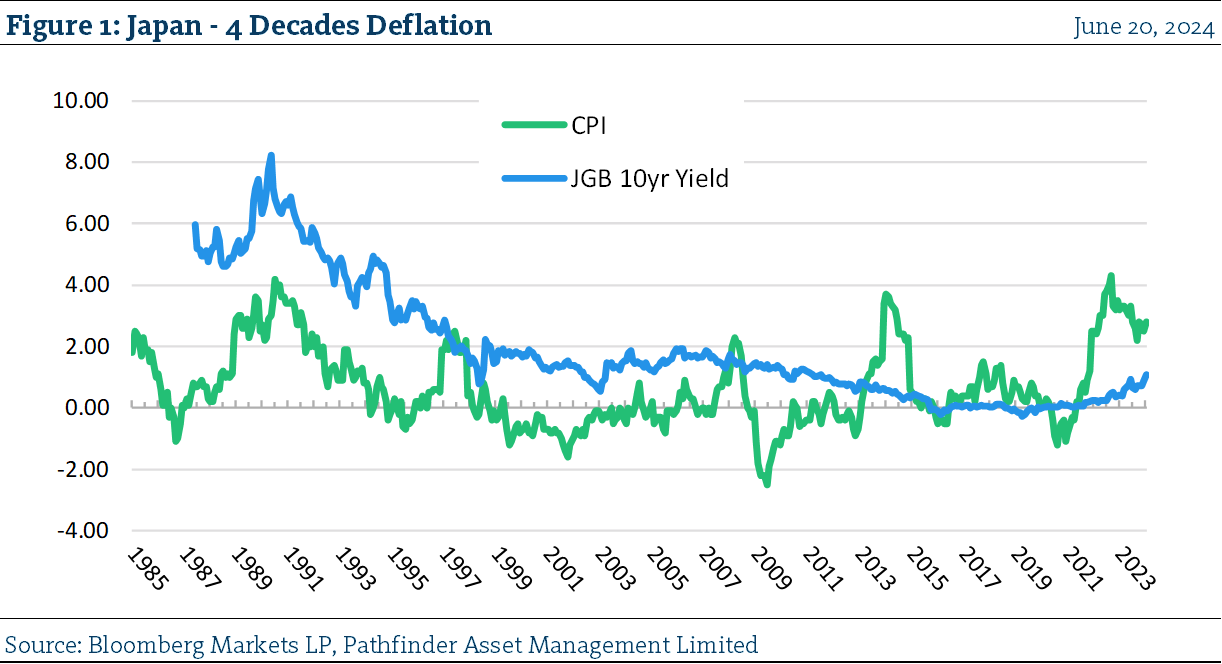Japan… finally
We have spent much of this year writing about the North American economy; in particular, the United States. This is because the US, once again, seems to be backstopping the global economy. We looked at the current GDP numbers for G20 nations and compared the recent performance of their economies. The US and other strong economies currently comprise 47.8% of global GDP. India is strongest, running at 7.8% annualized, but in terms of larger economies, Japan is the next best, growing at 3.6% annualized. Since the financial asset bubble of the 1990’s, Japan has been in an economic and deflationary slump. We have followed this market for some time and have just over 20% of the International Fund invested in Japan. Recently, the Japanese stock market (TOPIX) has approached its all-time high, set in December of 1989. The country now seems to be on the radar of the rest of the financial community. We thought that we would provide a few investment comments about this long-ignored market.
- Figure 1 presents the struggle with deflation that Japan has had over the last 40 years. With recent data, (stabilized CPI and increasing yields) we believe that the country has come out of this super cycle and is set to resume more normalized growth.

- The well publicized demographic trend is a negative, but the savings rate and the mountain of cash sitting on the sidelines (US $14 trillion according to Nikkei), that could be deployed in the stock market, is a potentially huge positive.
- We conclude that even with the recent strength in the stock market, valuation (less than 1.0x Price to Sales) remains cheap when compared to other large G7 economies. Also, corporate governance, a long-term complaint, has turned in the shareholder’s favour, with buybacks now becoming more normalized.
- Japan is not well followed. We count a little more than 4,500 publicly traded companies. Not many are covered by sell-side brokerage firms and many do not offer a non-Japanese based investor relations group.
“This means that” we see a lot of opportunity in Japan. While we have a significant allocation already, mostly in the technology sector, we believe that there is an information vacuum. With a bit of work, we can find new opportunities in difference sectors. We will update you again in the fall after our initial work is complete.
National Instrument 31-103 requires registered firms to disclose information that a reasonable investor would expect to know, including any material conflicts with the firm or its representatives. Doug Johnson and/or Pathfinder Asset Management Limited are an insider of companies periodically mentioned in this report. Please visit www.paml.ca for full disclosures.
Changes in Leverage. We are increasing the asset ceiling to 2.0 times the market value of equity for Pathfinder International Fund and Pathfinder Conviction Fund to be consistent with Pathfinder Partners’ Fund and Pathfinder Resource Fund.
*All returns are time weighted and net of investment management fees. Returns from the Pathfinder Partners’ Fund and Partners’ Real Return Plus Fund are presented based on the masters series of each fund. The Pathfinder Core: Equity Portfolio and The Pathfinder Core: High Income Portfolio are live accounts. These are actual accounts owned by the Pathfinder Chairman (Equity) and client (High Income) which contain no legacy positions, cash flows or other Pathfinder investment mandates or products. Monthly inception dates for each fund and portfolio are as follows: Pathfinder Core: Equity Portfolio (January 2011), Pathfinder Core: High Income Portfolio (October 2012) Partners’ Fund (April 2011), Partners’ Real Return Plus Fund (April, 2013), and Partners’ Core Plus Fund (November 2014).
Pathfinder Asset Management Limited (PAML) and its affiliates may collectively beneficially own in excess of 10% of one or more classes of the issued and outstanding equity securities mentioned in this newsletter. This publication is intended only to convey information. It is not to be construed as an investment guide or as an offer or solicitation of an offer to buy or sell any of the securities mentioned in it. The author has taken all usual and reasonable precautions to determine that the information contained in this publication has been obtained from sources believed to be reliable and that the procedures used to summarize and analyze such information are based on approved practices and principles in the investment industry. However, the market forces underlying investment value are subject to sudden and dramatic changes and data availability varies from one moment to the next. Consequently, neither the author nor PAML can make any warranty as to the accuracy or completeness of information, analysis or views contained in this publication or their usefulness or suitability in any particular circumstance. You should not undertake any investment or portfolio assessment or other transaction on the basis of this publication, but should first consult your portfolio manager, who can assess all relevant particulars of any proposed investment or transaction. PAML and the author accept no liability of any kind whatsoever or any damages or losses incurred by you as a result of reliance upon or use of this publication.